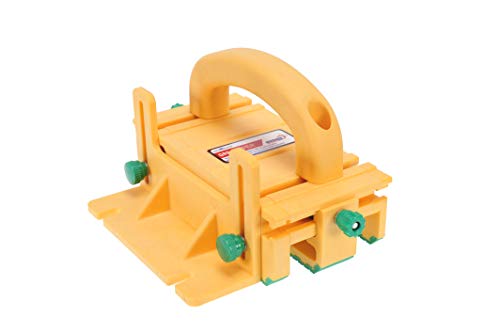When you're searching for the perfect table saw feeder to enhance your woodworking projects, you're in the right place. These devices guarantee effortless and precise cuts, transforming your experience in the workshop. With options like the Dual Bearing Roller Feather Boards and the SHOP FOX W1764 Mini Power Feeder, you're looking at a blend of innovation and practicality. Curious about what makes them stand out and how they can elevate your craft?
key Takeaways
- The Table Saw Feeder with Dual Bearing Roller Feather Boards offers adjustable roller height for safer, precise cuts.
- The Stock Roller Woodworking Tool features flexible PU wheels for enhanced friction and vibration dampening.
- The SHOP FOX W1764 Mini Power Feeder provides variable speed settings for efficient handling of lighter materials.
- The MICROJIG GRR-RIPPER Pushblock ensures 3-directional force control for total cutting precision and safety.
- The Aluminum Alloy Table Saw Feeder Guide Board delivers smooth, stable wood propulsion with flexible polyurethane wheels.
Table Saw Feeder – Dual Bearing Roller Feather Boards (2pcs)
If you're a woodworking enthusiast seeking a reliable and versatile tool, the Table Saw Feeder with Dual Bearing Roller Feather Boards is perfect for you. This carpentry safety propelling auxiliary tool boasts a high-strength aluminum alloy body with an anodized surface, making it durable, smooth, and rust-resistant. The rubber rollers enhance durability and shock absorption. It's compatible with #30 or #45 standard slots and adjustable for T-slots, fitting various machines like table saws and band saws. With flexible roller height adjustments and tilt feed, you guarantee safer operations and precise cuts. Rated 4.4 stars, it's a must-have tool.
Best For: Woodworking enthusiasts looking for a reliable, versatile, and safety-enhancing table saw accessory.
Pros:
- Durable high-strength aluminum alloy construction with anodized surface.
- Compatible with various machines and adjustable for different slot types.
- Features flexible roller height adjustment for precise and safer operations.
Cons:
- Limited to specific slot standards (#30 or #45).
- Might be too advanced for beginner woodworkers.
- Not the top-ranked option in table saw accessories.
Table Saw Feeder, Stock Roller Woodworking Tool
The Table Saw Feeder, Stock Roller Woodworking Tool is perfect for woodworkers seeking precision and efficiency in their projects. Its aluminum alloy body, anodized and CNC machined, guarantees durability and strength. With flexible PU wheels, you'll experience enhanced friction and vibration dampening, providing smooth and stable wood advancement. It's height adjustable, fitting wood thicknesses on a slide or T-slot, making it compatible with table saws, band saws, and more. This tool includes a feed, 2 T-slides, 2 T-screws, and 2 retaining rods. Plus, customer support is ready to assist with any questions or issues within 24 hours.
Best For: Woodworkers seeking precision, efficiency, and durability in their woodworking projects.
Pros:
- Durable aluminum alloy construction with anodized finish.
- Flexible PU wheels for enhanced friction and vibration dampening.
- Height adjustable to fit various wood thicknesses.
Cons:
- Limited to compatibility with 30 or 45 standard slots.
- May require additional setup time for initial installation.
- Not suitable for extremely heavy-duty woodworking tasks.
SHOP FOX W1764 1/8 HP Mini Power Feeder
Looking for a compact solution to enhance your milling efficiency? The SHOP FOX W1764 1/8 HP Mini Power Feeder might just be what you need. With a variable speed of 6-1/2 to 39 FPM, it handles lighter materials effectively, providing consistent cuts on long boards. While it may struggle with heavy stock, it excels in routing tongue and groove cuts. Installation is straightforward, though height adjustments can be tricky. Some users have noted wheel slippage and power limitations with dense woods. Despite mixed reviews, it reduces physical strain and boosts efficiency, making it a valuable addition to your workshop.
Best For: Hobbyists and small workshop owners looking for a compact and efficient solution to improve milling operations with lighter materials.
Pros:
- Reduces physical strain and eliminates the need for push sticks.
- Effective for routing tongue and groove cuts, enhancing milling efficiency.
- Straightforward installation on various shapers.
Cons:
- May struggle with heavy stock and dense woods like maple.
- Users report wheel slippage and potential power limitations.
- Height adjustment mechanism can be awkward and require additional spacers.
MICROJIG GRR-RIPPER GR-100 3D Table Saw Pushblock, Yellow
For woodworkers seeking enhanced safety and precision, the MICROJIG GRR-RIPPER GR-100 3D Table Saw Pushblock offers an excellent solution. This versatile tool provides 3-directional force, ensuring total control with downward, inward, and forward pressure. It's perfect for making precise cuts as narrow as 1/4" without moving the fence. The high-friction grip and adjustable features make it suitable for various tools, including table saws and jointers. Manufactured in the USA and backed by a 3-year warranty, the GRR-RIPPER enhances safety by protecting your hands from kickback and blade contact, making it a trusted choice for many woodworkers.
Best For: Woodworkers who prioritize safety and precision in their cutting tasks, especially those who frequently work with table saws, router tables, jointers, and band saws.
Pros:
- Provides 3-directional force for total control and safety.
- Allows for precise cuts as narrow as 1/4" without moving the fence.
- Fully adjustable to accommodate various tool sizes and handle angles for comfort.
Cons:
- May require an initial learning curve to use effectively.
- Higher initial investment compared to traditional pushblocks.
- Some users may find it bulky for smaller workshops or workspaces.
Aluminum Alloy Table Saw Pressing Feeder Guide Board for Woodworking
Ideal for woodworking enthusiasts seeking precision and durability, the Aluminum Alloy Table Saw Pressing Feeder Guide Board by Vislone delivers impressive performance thanks to its high-strength aluminum alloy construction. You'll appreciate its rustproof, wear-resistant design, enhanced by an anodic oxidation process for superior corrosion resistance. The flexible polyurethane wheels offer adjustable height, accommodating various wood thicknesses with ease. This guide board provides a smooth, stable wood propulsion, saving labor through its side push assisted effect. Though highly rated at 4.8 stars, some users mention issues with screw length and instructions. It's available with a 30-day return policy on Amazon.
Best For: Woodworking enthusiasts seeking a durable and precise feeder guide board for their table saws.
Pros:
- High-strength aluminum alloy construction ensures durability.
- Anodic oxidation process provides superior corrosion resistance.
- Adjustable polyurethane wheels accommodate various wood thicknesses.
Cons:
- Some users report issues with screw length.
- Lack of detailed instructions can complicate setup.
- Limited feedback availability due to a small number of reviews.
Factors to Consider When Choosing a Table Saw Feeder
When choosing a table saw feeder, you'll want to focus on a few key factors to guarantee you get the best fit for your needs. Consider the material and durability, as well as compatibility and expandability with your existing equipment. Don't overlook safety features, adjustability, and overall performance to ensure efficient and smooth operation.
Material and Durability
As you choose a table saw feeder, consider the material and durability to confirm long-lasting performance. Opt for models made from high-strength aluminum alloy with an anodized surface. This combination guarantees rust and wear resistance, enhancing the feeder's longevity and appearance. Rollers crafted from rubber or flexible polyurethane contribute to durability by absorbing shock and reducing vibration, resulting in smoother operation. Check for CNC machining in the manufacturing process, as this leads to precise fits and improved performance. Additionally, factor in the weight of the feeder. Heavier models offer better stability, minimizing movement during use and boosting safety and accuracy in your woodworking projects. Prioritizing these elements will help you select a reliable and efficient table saw feeder.
Compatibility and Expandability
Before you invest in a table saw feeder, verify it's compatible with standard slot sizes like #30 or #45 for straightforward installation across various machines. Choose a feeder that offers adjustable features, like height settings, to handle different wood thicknesses easily. This flexibility enhances usability and guarantees precise cuts. Consider feeders that can mount on either T-slots or slide options, giving you greater flexibility in setup and operation. It's wise to select a feeder suitable for multiple woodworking machines—table saws, band saws, and inverted engraving machines—to maximize utility. Also, check if the feeder components, such as rollers and guides, can be expanded or customized. This adaptability allows you to fit specific projects and improve performance over time.
Safety and Protection
Choosing a table saw feeder with safety and protection features is essential to ensuring a secure woodworking environment. A well-designed feeder reduces direct hand contact with the blade, minimizing the risk of kickback and accidents. Look for models with 3-directional force control for better handling and increased safety. Consistent downward pressure from a feeder stabilizes the workpiece, preventing unexpected movements during cuts.
High-quality feeders often have adjustable height mechanisms to accommodate different wood thicknesses, ensuring safer operation tailored to your materials. Additionally, using a feeder can alleviate physical strain, reducing fatigue and keeping your focus sharp on safe and precise cutting techniques. By prioritizing these features, you'll create a safer workspace and enjoy the benefits of effortless, accurate cuts.
Adjustability and Usability
To get the most out of your table saw feeder, consider its adjustability and usability. Look for feeders with height adjustability to accommodate various wood thicknesses, providing versatility for different projects. Ascertain it's compatible with standard slots like #30 or #45, so you can easily mount it on multiple machines, including table saws and band saws. Check for flexible roller height adjustment for better control and smoother material feeding. A tilt feed feature is beneficial for handling varying plate thicknesses, improving accuracy and safety during cuts. Evaluate the design for easy setup and adjustment mechanisms that let you make quick changes, enhancing usability in your woodworking tasks. These features guarantee your feeder adapts seamlessly to your needs.
Performance and Efficiency
When evaluating the performance and efficiency of a table saw feeder, consider features like variable speed settings that let you tailor the feed rate to different materials and thicknesses. Look for speed adjustments between 6.5 to 39 feet per minute to handle various projects effectively. Rubber or polyurethane wheels are fundamental for improving friction and dampening vibrations, ensuring smoother operation and reducing the risk of workpiece slippage. Adjustable height mechanisms are vital for different wood thicknesses, providing consistent material feeding. Effective dust collection ports can enhance efficiency by minimizing debris build-up, which might otherwise disrupt operations or affect cut quality. A well-designed feeder allows continuous feeding of long stock, maximizing material use and reducing waste in your woodworking tasks.
Installation and Setup
After considering the performance and efficiency of a table saw feeder, it's important to focus on the installation and setup process to guarantee ideal functionality. First, verify compatibility with your machine by checking if it fits standard slots like #30, #45, or T-slots. Follow the manufacturer's instructions for mounting, as most models offer straightforward installation on various shapers and operating tables. Adjust the feeder's height to match different wood thicknesses for smooth operation. Familiarize yourself with adjustment mechanisms, as some setups might need additional spacers for easier height changes. Before starting, secure all components and test the feeder with scrap pieces to verify it functions properly and safely. Proper setup guarantees effortless and precise cuts every time.







